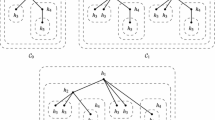Abstract
This is not a balance sheet of the domain, although twelve years is a good time for a research area to have an overall assessment, a comparison of initial dreams with the achievements, an overview of main results, an estimation of research directions for the near future. This would be too an ambitious task, although an useful exercise, so I am postponing it. What I want however to mention is that the initial aims were rather restricted, confined to computing theory, not imaging, for instance, that this area can become a framework for modeling, mainly of biological processes, but also for other areas. “There is nothing more practical than a good theory” one often says. Membrane computing proved to be practical; whether or not this means that it provides a good theory, let us assess it after twelve more years.
The presentation here has two main aims.
First, it tries to introduce membrane computing through twelve basic ideas about which I have worked along the years: cell-like P systems, string objects, symport-antiport rules (computing by communication), active membranes (especially, membrane division and membrane creation), tissue-like P systems, using P systems in the accepting mode, trace languages, numerical P systems, P systems with objects on membranes (brane calculi inspired P systems), P colonies, spiking neural P systems, dP systems. Other topics will be touched, having or not connections with my work: controls on rule application, minimal parallelism, asynchronous systems, array objects, trees as a result of computations, population P systems, conformon objects, probabilistic-stochastic P systems, MP systems, complexity approaches, and so on. Also, some open problems and research topics will be mentioned.
Second, some hints will be given concerning applications, especially in modeling biological processes, but also in studying-simulating ecosystems; applications in economics, computer graphics, approximate optimization, etc., will be also mentioned.
Very few precise bibliographical information will be given. Instead, the reader will be refereed to the existing books available – see below – and to the website of membrane computing, from http://ppage.psystems.eu. A lot of information can also be found in the proceedings of the two yearly meetings in the area, Brainstorming Week on Membrane Computing and Workshop on Membrane Computing (the latter one being the ancestor of the present conference), in the PhD theses with membrane computing subject, and in the special issues of journals devoted to membrane computing; details about all these can be found in the above mentioned website.
Access this chapter
Tax calculation will be finalised at checkout
Purchases are for personal use only
Similar content being viewed by others
References
Ciobanu, G., Păun, G., Pérez-Jiménez, M.J. (eds.): Applications of Membrane Computing. Springer, Berlin (2006)
Frisco, P.: Computing with Cells. Advances in Membrane Computing. Oxford Univ. Press, Oxford (2009)
Păun, A.: Computability of the DNA and Cells. Splicing and Membrane Computing. SBEB Publ., Choudrant (2008)
Păun, G.: Membrane Computing. An Introduction. Springer, Berlin (2002)
Păn, G., Rozenberg, A., Salomaa, A. (eds.): Handbook of Membrane Computing. Oxford University Press, Oxford (2010)
Author information
Authors and Affiliations
Editor information
Editors and Affiliations
Rights and permissions
Copyright information
© 2010 Springer-Verlag Berlin Heidelberg
About this paper
Cite this paper
Păun, G. (2010). Membrane Computing at Twelve Years. In: Gheorghe, M., Hinze, T., Păun, G., Rozenberg, G., Salomaa, A. (eds) Membrane Computing. CMC 2010. Lecture Notes in Computer Science, vol 6501. Springer, Berlin, Heidelberg. https://doi.org/10.1007/978-3-642-18123-8_1
Download citation
DOI: https://doi.org/10.1007/978-3-642-18123-8_1
Publisher Name: Springer, Berlin, Heidelberg
Print ISBN: 978-3-642-18122-1
Online ISBN: 978-3-642-18123-8
eBook Packages: Computer ScienceComputer Science (R0)




